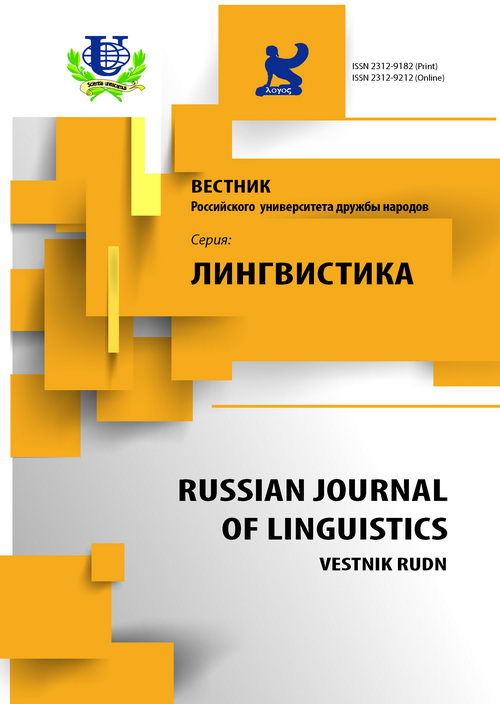Interpretation Specificity of US Court Opinions
- Authors: Lutskovsakya L.Y.1
-
Affiliations:
- Law institute Peoples’ Friendship University of Russia
- Issue: No 3 (2015)
- Pages: 113-121
- Section: Articles
- URL: https://journals.rudn.ru/linguistics/article/view/9430
Cite item
Full Text
Abstract
The article focuses on interpretation of English-language texts of court opinions. The author briefly considers existing models of text comprehension, while opting for cognitive approach as the basis for analysis of the judicial discourse. The article provides a meta-language developed as analysis methodology of linguistic means of frames’ representation. US court opinions were used as material for analysis. The author also suggests that linguistic means of modus functions’ representation frequently create additional senses in judicial discourse. The paper concludes that the reference to precedent, in addition to the functions of legal reasoning, performs evaluative function, expressing the meaning of speaker’ high degree confidence in what is being reported.
About the authors
Larissa Yu Lutskovsakya
Law institute Peoples’ Friendship University of Russia
Email: laravas@list.ru
Foreign Languages Department
References
- Атабекова А.А., Василенко Л.Ю. Аргументация в тексте судебного решения // Вестник ЧГУ, серия: «Филология, искусствоведение». Вып. 58. № 25. Челябинск, 2011. С. 19-22.
- Глинская Н.П. Юридическая терминология в разных функциональных стилях английской речи: Автореф. дисс.. канд. филол. наук М., 2002.
- Демьянков В.З. Лингвистическая интерпретация текста: Универсальные и национальные (идиоэтнические) стратегии // Язык и культура: Факты и ценности: К 70-летию Юрия Сергеевича Степанова / Отв. редакторы: Е.С. Кубрякова, Т.Е. Янко. М.: Языки славянской культуры, 2001. С. 309-323.
- Дубровская Т.В. Судебный дискурс: речевое поведение судьи (на материале русского и английского языков). М.: Академия МНЭПУ, 2010.
- Официальный сайт Апелляционного суда США (7 округ). URL: www.ca7.uscourts.gov (09.02.2015).
- Падучева Е.В. Семантические исследования: Семантика времени и вида в русском языке; Семантика нарратива. 2-е изд., испр. и доп. М.: Языки славянской культуры, 2010.
- Хомский Н. Язык и мышление. М., 1972.
- Чернышева З.З. Средства создания скрытой информации в тексте (лингвокультурологический и когнитивный аспекты): курс лекций. Уфа: Изд-е Башкирс. ун-та, 2000.
- Шейгал Е.И. Семиотика политического дискурса. М., 2004.
- Bresnan J. A realistic transformational grammar. Linguistic theory and psychological reality. Cambridge, MA: MIT Press, 1978. P. 1-59.
- Cotterill J. Language in the legal process. Hapshire, UK: Pelgrave, 2002.
- Cross F.B., Pennebaker J.W. (2014) The language of the Roberts court. Michigan State Law Review. URL: http://digitalcommons.law.msu.edu (5.05.15).
- De Cruz P. (2007). Comparative law in a changing world. 3rd ed. London & New York: Routledge - Cavendish.
- George J.F. (2007). Judicial opinion writing handbook. 5th ed. Buffalo: Hein& Co.
- Goodman A. (2006). How judges decide cases: Reading, writing and analyzing judgements. St. Albans: XPL.
- Hansford T.G., Coe Ch. (2014) Linguistic Complexity and Public Acceptance of Supreme Court Decisions. Washington, DC: AMAPSA.
- Hunston S., Thompson G. (eds.). (2000). Evaluation in text. Oxford.
- Levy J. (1994). Language as evidence: The linguist as expert witness in North American courts. Forensic linguistics 1.1-26.
- Liu H., Lieberman H., Selker T. A model of textual affect sensing using real-world knowledge, In Proceedings of IUI, Miami (P. 25-132). New York: ACM Press, 2003.
- Matilla H.E.S. Comparative legal linguistics. Aldershot: Ashgate, 2006.
- Nuyts J. Epistemic modality, language, and conceptualization: A cognitive-pragmatic perspective. Amsterdam, Philadelphia, 2001.
- Posner R.A. (2013) Judicial opinions and appellate advocacy in Federal courts - one Judge’s views. 51 Duquesne Law Review 3.
- Shuy R.W. The language of confession, interrogation and deception. Thousand Oaks, CA: Sage, 1998.
- Simon-Vandenbergen A.M., Aijmer K. The semantic field of modal certainty. A corpus-based study of English adverbs. Berlin, New York, 2007.
- Thompson S.A., Mulac A. (1991). A quantitative perspective on the grammaticalization of epistemic parentheticals in English. Traugott E.C., Heine B. (eds.). Approaches to grammaticalization. Amsterdam, Philadelphia: 313-339.
- Turney P.D., Littman M.L. (2003). Measuring praise and criticism: Inference of semantic orientation from association. ACM Transactions on Information Systems (TOIS), 21(4): 315-346.
- Wetter J.G. The styles of judicial opinions. A case study in comparative law. Leyden: Sythoff, 1960.

















